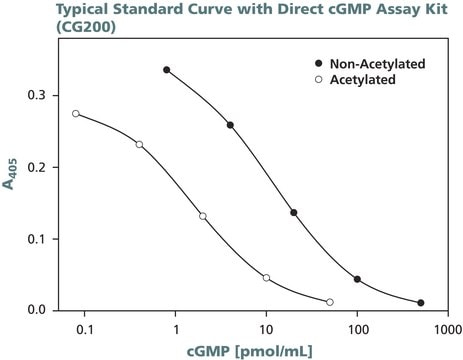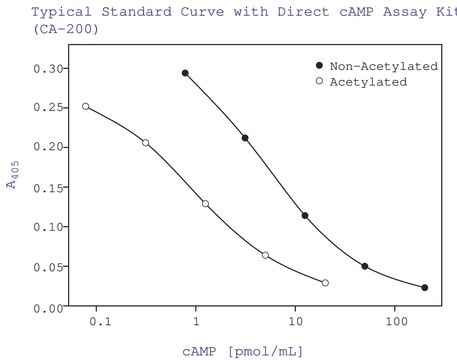Kluczowe dokumenty
CG201
cGMP Enzyme Immunoassay Kit
sufficient for 96 assays
Wybierz wielkość
3500,00 zł
Wybierz wielkość
About This Item
3500,00 zł
Polecane produkty
zastosowanie
sufficient for 96 assays
Poziom jakości
metody
ELISA: suitable
Warunki transportu
wet ice
temp. przechowywania
−20°C
informacje o genach
human ... PRKG1(5592)
Opis ogólny
Zastosowanie
Tylko elementy zestawu
- Acetic Anhydride 1 x 1
- Assay Buffer 2 1 x 30
- cGMP-Alkaline Phosphatase Conjugate 1 x 5
- cGMP Assay Layout Sheet 1 x 1
- cGMP EIA Antibody Rabbit Anti-cGMP 1 x 5
- 5 Cycle Logit-Log Paper 1 x 1
- Cyclic GMP Standard 1 x 0.5
- Goat Anti-Rabbit IgG Coated 96 Well Microtiter Plate 1 ea
- p-Nitrophenyl Phosphate Substrate Solution 1 x 20
- Plate Sealer 1 ea
- Stop Solution 1 x 5
- Triethylamine 1 x 2
- Wash Buffer Concentrate 1 x 30
Hasło ostrzegawcze
Danger
Zwroty wskazujące rodzaj zagrożenia
Zwroty wskazujące środki ostrożności
Klasyfikacja zagrożeń
Acute Tox. 2 Inhalation - Acute Tox. 3 Dermal - Acute Tox. 4 Oral - Eye Dam. 1 - Flam. Liq. 2 - Skin Corr. 1A - STOT SE 3
Organy docelowe
Respiratory system
Kod klasy składowania
3 - Flammable liquids
Temperatura zapłonu (°F)
12.2 °F - closed cup
Temperatura zapłonu (°C)
-11 °C - closed cup
Wybierz jedną z najnowszych wersji:
Masz już ten produkt?
Dokumenty związane z niedawno zakupionymi produktami zostały zamieszczone w Bibliotece dokumentów.
Klienci oglądali również te produkty
Active Filters
Nasz zespół naukowców ma doświadczenie we wszystkich obszarach badań, w tym w naukach przyrodniczych, materiałoznawstwie, syntezie chemicznej, chromatografii, analityce i wielu innych dziedzinach.
Skontaktuj się z zespołem ds. pomocy technicznej







![Western Blocking Reagent, Solution solution, sufficient for 10 blots (11921673001 [100 cm2]), sufficient for 60 blots (11921681001 [100 cm2])](/deepweb/assets/sigmaaldrich/product/images/352/091/ef743cea-ccd8-44f1-8f3b-dec5a1e4f5d1/640/ef743cea-ccd8-44f1-8f3b-dec5a1e4f5d1.jpg)





